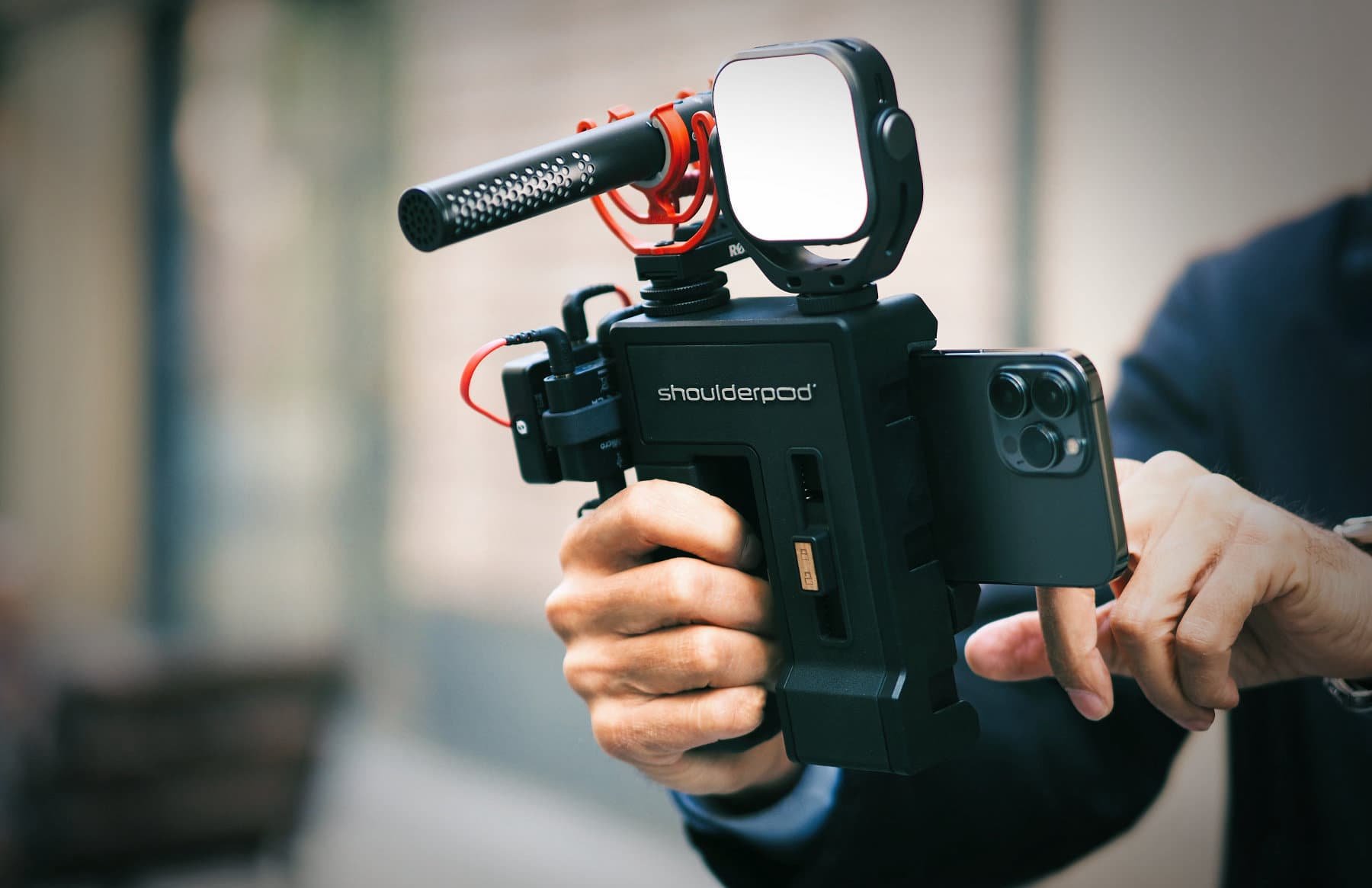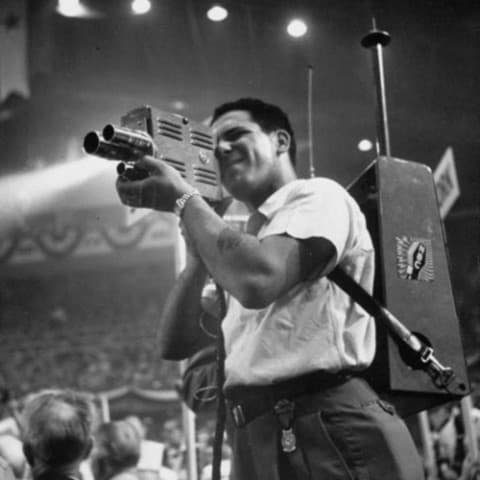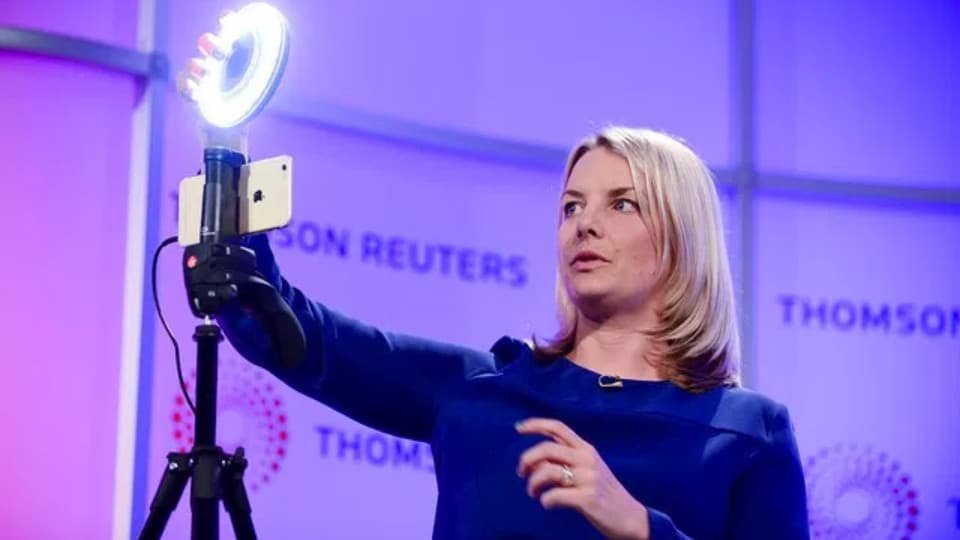
Mobile
Journalism
What is Mobile Journalism?
Mobile Journalism is a new workflow for media storytelling where reporters are trained and equipped for being fully mobile and fully autonomous
A Mobile Journalist or MOJO is a freelance or staff reporter that uses mobile devices such as smartphones, tablets or laptopts for gathering, shooting, live broadcasting, editing and sharing news.
Empowering the individual storyteller
"Mobile Journalism is about empowering the individual storyteller to use whatever consumer technology they have available to them to make the best possible visual story that they can."
Glen Mulcahy
Founder of Mojocon & Mojofest
3 stories behind mobile journalism
How journalists have always been ahead of innovation for going mobile
1925 - THE PRINTED PRESS AND THE LEICA: The history of mobile journalism could not be fully understood without going back to the release of the first Leica in 1925. The small 35 mm camera designed in 1913 by Oskar Barnack at the workshops of the German company Leitz, was not only a great technological innovation, but also represented an authentic conceptual revolution that would change 20th-century photojournalism. The Leica 1 gave photographers and reporters the freedom to move around, enabling them to leave their heavy equipment in the studio and go outside. This meant that they could now focus on capturing moments, on the action, on telling visual stories as they happened. As an example, the work of renowned photojournalists like Robert Capa or Henri Cartier-Bresson and the establishment of the Magnum agency in 1947 would never have been possible without their small Leicas.
1953 - THE TV AND THE "WALKIE-LOOKIE": By the late 1930s, after the first broadcasting tests, it was clear that television would drastically change the way we were informed and entertained in the years to come. However, recording equipment was bulky and heavy and could only be used inside studios and on sets. At best, it could be transported in large trucks to cover special events, such as the coronation of Queen Elizabeth II in 1953, which was undoubtedly a key milestone in the history of the BBC. But it was not until the introduction of the Walkie-Lookie from RCA - the first truly portable camera - that reporters could go out and move among the people. Only then could the world experience, in real time and without leaving their couches, what was going on out there, albeit still in black and white.
2007 - THE INTERNET AND THE IPHONE: During the 1990s, the internet began to amass a tremendous amount of information and soon became the place where everyone would go to find out what was going on in the world. But updating content was not an easy task, nor one that was accessible to just anyone. The following decade was key, with the arrival of Web 2.0 facilitating user interaction, blogs popping up and social media networks being born. However, editing still had to be done from a computer in the office. In 2007, the release of the iPhone changed everything. It changed the way we communicated, listened to music, got informed... but it especially changed the way all humanity started creating and sharing content in a fast, easy and global way. Just as with the first Leica, journalists immediately saw the opportunity of this new technology and started using their smartphones to completely change the way they created and shared stories in the new digital society.
By relying solely on myself, I am now able to report on events as they unfold, allowing me to send my video-stories much faster.
Why mobile journalism?
6 powerful reasons why thousands of freelance journalists, media companies and broadcast corporations have gone mojo
1. It’s easy
You probably already know how to use the camera on your smartphone, and if you're a journalist, you likely know how to tell an engaging story. Smartphones have broken down many of the technological barriers that used to exist between your stories and your audience, turning video production into something that anyone can do with just a few hours of training and a bit of practice.
PETER KERESZTES LEARNS MOJO IN 4 DAYS: Peter Keresztes is a journalist from TVR Timișoara, Romania. He was trained for four days on how to film and edit on his smartphone during the Mojo Challenge 2015, a competition organized by CIRCOM and MTVA where journalists from across Europe compete for excellence in mobile storytelling. At the end of the week, each participant has to find, shoot, edit and publish a story. Peter's first video ever; "Homeless Baths", is a clear example of how you can learn the art of mobile journalism in only a few days. Watch the video and judge for yourself.
2. It’s fast
Be the first to broadcast a breaking news or event. Other media outlets will have to arrange a full broadcast crew, make sure all the necessary equipment is available, get to the location and set up everything upon their arrival before going live. A MoJo, however, only needs to pick up their backpack, get there and start broadcasting.
GO LIVE IN 90 SECONDS: "With some stories happening so quickly, they need to be covered before a full broadcast team can get there. Turning to mobile journalism is becoming an increasingly common response”. Learn how Harriet Hadfield, a former reporter at Sky News, goes live in 90 seconds with her smartphone. Read the full article by Thalia Fairweather for Newsrewired here.
3. Go unnoticed
Mobile Journalists can go unnoticed thanks to their small equipment. Smartphones are not typically perceived as press cameras, so they allow you to shoot stories in places where standard video journalists would never dare to venture.
REPORTING FROM SYRIA: An Al Jazeera journalist, forced to remain anonymous for security reasons, shot an unusual but compelling first-person documentary of a country in turmoil and a revolution in progress using his smartphone. “Because carrying a camera would have been risky, I took my cell phone with me as I moved around the country,” the undercover reporter states in the documentary. He adds that with an iPhone, he was able to film unobtrusively and get into places that would have been impossible with a traditional TV camera.
4. Get closer
Having a lightweight and compact equipment that fits into a small messenger bag is a great advantage for getting closer to some stories. Big cameras with extra lighting and sound equipment are simply too large to get into some places. No matter if you are in a conference hall, a plane, or a cave, set up your mobile gear and tell the story to your audience.
INSIDE A CAVE WITH LEONOR SUAREZ: Leonor Suarez is the Editor-in-Chief of Asturias' public Radio and TV. Winner of the Thomson Foundation Mobile Journalism Awards in 2016, she was the first reporter to film inside the caves of Pozu'l Fresno in Spain. "Now we can share these amazing images with the world," Leonor said. "Filming with a smartphone is easier, lighter, and allows me to introduce the camera in places where traditional equipment would never arrive."
5. Break barriers
People are less intimidated when being interviewed with a smartphone than with a big camera. It is much more discreet, less intrusive and more familiar, so people tend to be more sincere and open as a result. Break down barriers between your audience and the story by going mobile.
THE INTERESTING STUDY OF PANU KARHUNEN: In his research, "Closer to the Story? Accessibility and Mobile Journalism," Finnish news editor for ISTV, Panu Karhunen, tries to find out how mobile journalism affects accessibility. As part of his investigation, Karhunen approaches 200 people at a commercial center with basic MoJo equipment and 200 more with a conventional TV camera. Guess which setup got more responses? Watch the video to learn how mobile journalism can lead to a more genuine and intimate journalism.
6. Save costs
Mobile journalism can help you or your organization save costs, not only at the time of purchasing new equipment but also when training personnel or maintaining your gear. One of the reasons why mobile journalism is growing so rapidly is due to its impact on the bottom line for freelance journalists, medium-sized production companies, or large broadcasting corporations.
THE STORY OF FALKLAND ISLANDS TV: Born in 2011 with a tight budget, the small national broadcast media, Falkland Islands Television, bets on using mobile equipment to allow reporters produce more efficient and fast content both for TV and social media. Read the full story on this article written by Caroline Scott for Journalism.co.uk: “Tackling wind and crowds on a small budget: Mobile journalism in the Falkland Islands” and learn how you can save costs by moving into Mobile Journalism.
Lessons from the BBC
The Newsroom in their pockets
"Shrinking budgets and growing demands - that's the contradictory conundrum facing many news organisations globally, not just the BBC. But we're trying to tackle this challenge by getting our staff to understand how to get the best out of the "newsroom in their pocket" - their smartphone. Whenever possible, we'll still send news crews to cover stories using broadcast cameras but we can't cover as many stories as we'd like, nor can we get to those stories as quickly as we'd like. That's where the smartphone comes in. Used properly - keeping it steady, thinking about sound, light, and framing - this one device means we have the equivalent of thousands of news crews deployed all over the world, ready to spring into action once the big story breaks. Mobile journalism is the biggest revolution in news in decades and it's time everyone jumped on board".
Marc Settle
Mobile Journalism Trainer
BBC
Trusted by the best
Shoulderpod is the European specialist in smartphone video equipment trusted by more than 130.000 professionals from around the world
In a content-saturated world, professionals need to stand out from the crowd.
How to get started on mobile journalism
13 things you definitely need for going mojo
Update your mindset: First things first. Going Mojo requires a completely new workflow. Make sure you and your organization are mentally prepared and open to innovation. Read the article.
Keep it simple: When choosing your equipment, get only what you really need. This will help you focus on your stories and not on your gear. Once you feel comfortable, grow your kit.
Smartphone: iPhone or Android, both work well as far as the model you use has a good camera. Multi-camera models are always better, but start with the device you already have.
Smartphone grip: Buy a grip capable of holding together all the gear you need. Make sure it is comfortable to use and reliable. It will be the core of your video setup.
Tripod: You will need a full-size tripod for shooting interviews, b-roll clips or pieces-to-camera. Get a sturdy, compact and light-weight model.
Microphones: This is an important one! You will probably need a lavalier microphone for interviews, a reporter hand-held mic for pieces-to-camera and a shotgun mic for ambience sound. If you don’t like messing around with cables, try going wireless.
Video light: Not absolutely necessary but it will help you under some special conditions like dark indoors or night shots. Choose a model with light-dimming and colour-temperature controls.
Power bank: Shooting video will drain your smartphone’s battery faster that you might expect. Have a fully charged power-bank always with you. Just in case!
Cables and connectors: From charging cables to mic adapters, prepare a little bag with all your stuff. Keep it tidy so you can set up your gear in seconds.
Backpack or messenger bag: Travel light but make sure you have everything you need always with you. You are a one-man-band now.
Apps: There’s a whole world of options here. Download at least a pro filming app and a video editor. Don’t expect the good ones to be free!
Training: If you are a medium or large organization, hire a professional mojo trainer. You'll save time and money! If you are a freelance journalist, look for online courses and tutorials.
Practice: Once you have all the above, there are three more things you need: practice, practice and practice. This is the only way to become a Mojo Master and tell stories that stand out from the crowd.
Build your own mojo kit
Because the right tools in the right hands can make change happen. Select all the gear you need but keep it simple. If you require any support to build your personal mojo kit, feel free to contact us using the chat button. We’re here to help!


















